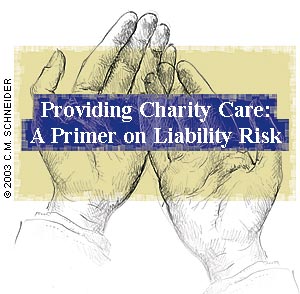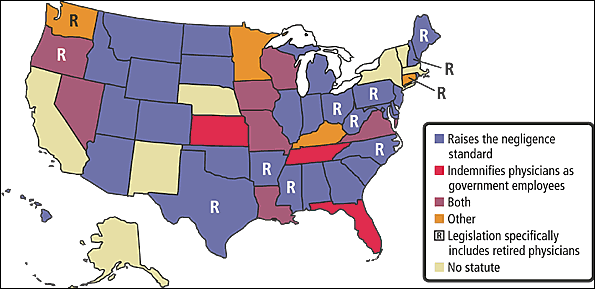
If there’s a bright spot in the medical liability system, it’s in the laws protecting physicians who volunteer to care for the uninsured.
Fam Pract Manag. 2003;10(1):52-54

Liability exposure is usually one of the first questions raised by physicians interested in volunteering to care for the uninsured. Few liability claims arise from these charitable efforts, however, and physicians who volunteer in free clinics and other community initiatives have some liability protection under state law as well as under a federal statute.
Charitable immunity laws
Currently, there are charitable immunity laws in 43 states and the District of Columbia. States without charitable immunity laws include Alaska, California, Massachusetts, Nebraska, New Mexico, New York and Vermont. These laws are distinct from “Good Samaritan” laws, which protect health care professionals providing care in emergency situations. Charitable immunity laws make it more difficult for plaintiffs to win a liability claim, but do not guarantee that volunteers won’t face litigation.
Physicians concerned about liability exposure may want to obtain a copy of the Charitable Immunity Manual: A Review of U.S. Charitable Immunity Legislation for Volunteer Health Care Providers.1 It includes a state-by-state table summarizing statutory provisions (see the box on page 54) and is available free from Volunteers in Health Care (www.volunteersinhealthcare.org/manuals/charit.imm.man.pdf), a national non-profit resource center for organizations and volunteer clinicians caring for the uninsured.
State laws
Historically, state laws have controlled malpractice liability and most states have chosen one of two routes to protect volunteer physicians. Some raise the negligence standard of care from simple negligence to gross negligence. Often called a “willful or wanton” or “reckless” standard, it makes negligence more difficult to prove. This approach is also used in the federal statute. Other states indemnify the volunteer clinician as if he or she were a government employee. Under this model, referred to as the “state tort claims act,” the state establishes a legal defense fund to cover monetary damages as well as legal defense costs. Often these statutes place caps on the total amount of compensation that can be paid. Certain conditions may be specified, such as the setting in which the care is delivered or the existence of a formal agreement between the clinician and the state.
Florida, for example, appears to have found a successful formula through its Volunteer Health Care Provider Program. Under a 1992 law, physicians enter into an agreement with the state to care for uninsured patients and are extended the state’s sovereign immunity protection. One study of the Florida initiative found that 18,000 volunteer practitioners provided services valued at $66 million in fiscal year 1999–2000.2
Neither of the two major approaches completely limits a patient’s right to initiate a liability action against a volunteer or ensures that a lawsuit will be easily dismissed. According to Paul Hattis, MD, JD, MPH, the manual’s lead author, changing the negligence standard raises the bar for plaintiffs and indemnity under a state tort claims act can protect against financial loss. Several states combine aspects of both models.
Other approaches to protecting physician volunteers are summarized in the charitable immunity manual. For example, several states (e.g. Connecticut, Washington) provide a mechanism for subsidizing the purchase of malpractice insurance. Twelve states (e.g., Arkansas, Texas, Ohio) have statutory provisions designed to encourage retired physicians to volunteer.
KEY POINTS
Many physicians are concerned about the risk of liability exposure for providing charity care.
Laws in many states protect physicians by raising the standard of negligence or by indemnifying them with liability protection as if they were government employees.
Charitable immunity laws make it more difficult for physician volunteers to be sued, but don’t guarantee that they won’t face litigation.
Federal legislation
To encourage individuals reluctant to volunteer for fear of being sued, Congress passed the Volunteer Protection Act of 1997. According to the charitable immunity manual, a volunteer clinician acting within his or her scope of duties in a nonprofit organization is protected from liability for simple negligence. (There are exceptions for misconduct related to crimes of violence, sexual offenses and civil rights violations, among others.) Even if the volunteer is held liable for gross negligence, the Volunteer Protection Act limits punitive damages to those cases in which there is clear and convincing evidence of willful or criminal misconduct or conscious, flagrant indifference to the rights or safety of the individual harmed. The act also limits awards for non-economic damages (e.g., pain and suffering) to the proportion of harm caused by the volunteer.
Critics of the Volunteer Protection Act say that plaintiffs will simply claim gross negligence. (Momans v St. Johns Northwestern Military Academy Inc. might have tested the Volunteer Protection Act, but did not move forward in court.) However, in those states with weaker or nonexistent protections, federal law affords the volunteer clinician at least some measure of protection.
The legal impact
Charitable immunity laws seem to have a deterrent effect. A survey of 104 clinics in 33 states conducted by Volunteers in Health Care found that physicians who volunteer to care for the uninsured are rarely targets of malpractice claims. Provisions such as raising the negligence standard of care seem to discourage plaintiffs from filing frivolous claims, which in turn eases physicians’ concerns about volunteering. Because they seem to have stabilized the liability situation, at least in the volunteer context, charitable immunity laws may also make it easier and less expensive for insurance companies to provide malpractice coverage to volunteer clinicians.
Encouraging volunteerism
For the foreseeable future, free clinics and similar voluntary efforts are likely to remain an important component of the health care safety net. Physicians and their professional societies committed to expanding care for uninsured patients would do well to inform their colleagues that liability concerns should not be an obstacle to volunteering.
AN OVERVIEW OF CHARITABLE IMMUNITY LAWS
A state-by-state examination of charitable immunity laws reveals the individuality of response to the issue. No state law looks exactly like another’s. Nevertheless, a few summary statements can be made.
43 states and the District of Columbia have some sort of charitable immunity legislation.
Seven states don’t have charitable immunity laws. They include Alaska, California, Massachusetts, Nebraska, New Mexico, New York and Vermont.
12 states specifically reference retired physicians in their charitable immunity statutes; three states (Pennsylvania, West Virginia and Washington) have legislation only for retired physicians.

Source: Hattis PA, Staton S. Charitable Immunity Manual: A Review of U.S. Charitable Immunity Legislation for Volunteer Health Care Providers. Providence, RI: Volunteers in Health Care; 2002. Available at: www.volunteersinhealthcare.org/Manuals/charit.imm.man.pdf. Accessed Dec. 9, 2002.